Initially, Intel Core Ultra 200 Arrow Lake CPUs will launch with unlocked K variants. The new series could perform poorly in games.
After months of speculations and leaks, Intel has finally announced the launch of Intel Core Ultra 200 Arrow Lake CPUs for desktops. Because they are desktop variants, Intel is calling it Intel Core Ultra 200S series.
Intel Arrow Lake is going to be the first ever CPU series by Intel with tile based architecture for desktop. It will use an entirely new LGA1851 socket. It also introduces PCIe 5.0 for both GPU and NVMe drives.
With the new Arrow Lake series, Intel promises 9% uplift in performance for P-cores and a massive 32% uplift in performance of E-cores.
After two decades, Intel CPUs will not come with any Hyper-Threading enabled in them. Not only that, for the first time, Intel introduces a NPU chip for AI in its desktop CPUs.
In the announcement, Intel has initially launched just five variants, let us look at them.
Intel Core Ultra 200 Arrow Lake Specs
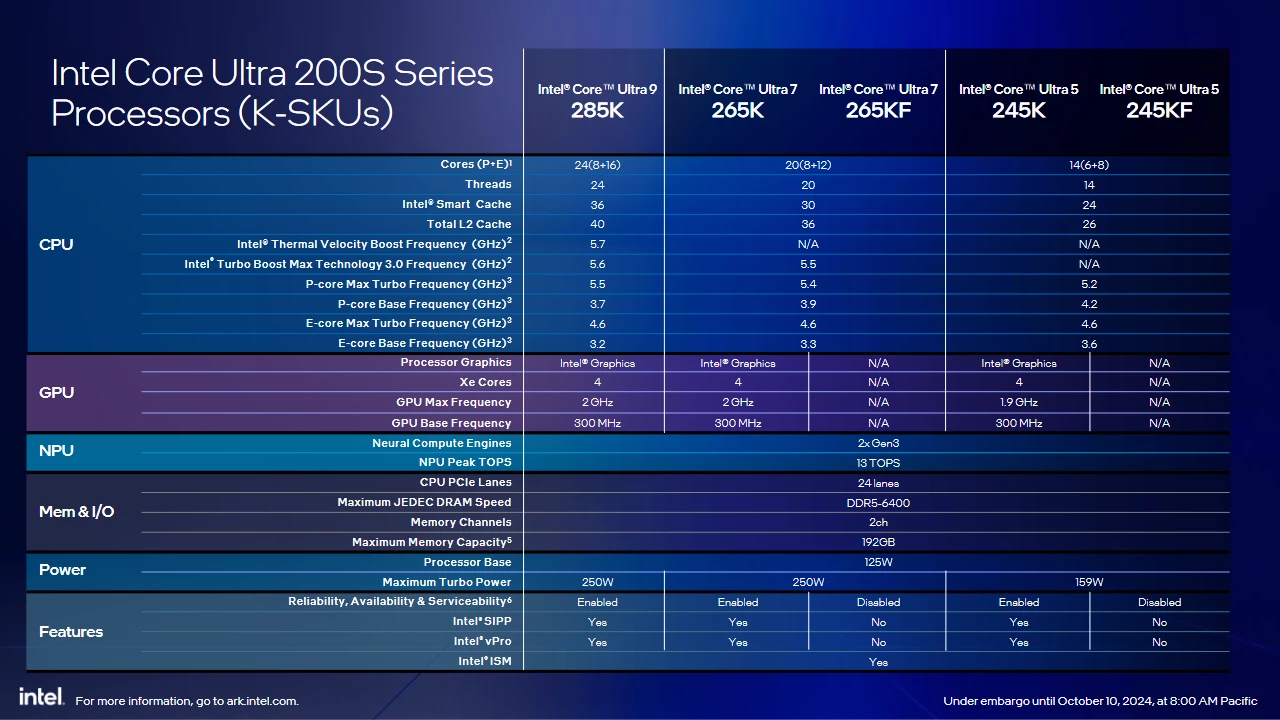
Intel Core Ultra 9 285K
The first in the list is the Intel Core Ultra 9 285K CPU. It will come with 24 Cores and threads, that is 8 P-Cores and 16 E-Cores. This going to be a successor of the Intel Core i9-14900K CPU.
In terms of CPU clock, the Thermal Velocity Boost (TVB) will reach 5.7GHz (300MHz lower than i9-14900K), the Turbo Boost Max Technology 3.0 (TBM 3.0) will be 5.6GHz, P-core Max Turbo will be 5.5GHz and the P-core Base will be 3.7GHz. The E-core Max Turbo will be 4.6GHz, whereas the base speed will be 3.2GHz.
The CPU will have 40MB of total L2 cache and 36MB of L3 cache. The L2 cache sees an increase of 8MB here, whereas the L3 cache remains the same.
The Maximum Turbo Power will be 250W, a mere 3W decrease over previous-gen.
It will have 4 XE iGPU cores running at max 2GHz, while the GPU’s base frequency will be 300MHz. Surprisingly, Intel has not announced any F non-iGPU variant for the 285K CPU.
Intel Core Ultra 9 285K will come at a price of $589. Same as the MSRP of Intel Core i9-14900K CPU.
Intel Core Ultra 7 265K/F
The Intel Core Ultra 7 265K and Intel Core Ultra 7 265KF (without iGPU) will come with 20 Cores and threads, that is 8 P-Cores and 12 E-Cores in them. These CPUs are a successor for the Intel Core i7-14700K and i7-14700KF CPUs.
They will not have TVB clocks, but the TBM 3.0 clocks will reach 5.5GHz and the P-core Max Turbo will be 5.4GHz with the P-core Base being 3.9GHz. The E-core Max Turbo will be 4.6GHz, whereas the base speed will be 3.3GHz. The Maximum Turbo Power will be 250W.
The total L2 cache here too sees an increase from 23MB (in i7-14700K/F) to a massive 36MB, whereas the L3 cache decreases from 33MB to 30MB.
Just like the 285K, the 265K will have 4 XE iGPU cores running at max 2GHz. The KF variant doesn’t have any iGPU as always.
Intel Core Ultra 7 265K will come at a price of $394, about $15 cheaper than Intel Core i7-14700K. The KF variant will come price of $379. That’s $5 cheaper than its predecessor.
Intel Core Ultra 5 245K/F
The Intel Core Ultra 5 245K and Intel Core Ultra 5 245KF will come with 14 cores and threads. With 6 P-Cores and 8 E-Cores. These CPUs succeed Intel Core i5-14600K and Intel i5-14600KF CPUs.
They will not have TVB clocks and TBM 3.0 clocks, the P-core Max Turbo will be 5.2GHz with the P-core Base being 4.2GHz. The E-core Max Turbo will be 4.6GHz, whereas the base speed will be 3.6GHz. The Maximum Turbo Power will be 159W, this is 22W less than Intel Core i5-14600K.
The total L2 cache here too sees an increase from 20MB (in i5-14600K/F) to 26MB, whereas the L3 cache remains the same at 24MB.
The 245K will have 4 XE iGPU cores running at max 1.9GHz, while the GPU’s base frequency will be 300MHz. The KF variant doesn’t have any iGPU as always.
Intel Core Ultra 5 245K will come at a price of $309, about $10 cheaper than Intel Core i5-14600K. The KF variant will come price of $294. That’s the same as its predecessor.
NPU & Shared Specs
All the above CPUs will come with two Gen3 NPU chips with 13 peak TOPS. These CPUs will support max 24 PCIe lanes.
They will support maximum JEDEC DRAM speeds of DDR5-6400, with no support for DDR4. Tom’s Hardware says Intel suggests that DDR5-8000 is the sweet spot. All these CPUs support dual-channel memory with a total maximum capacity of 192GB, that is 48GB per DIMM stick. It will also support UDIMM, CUDIMM, SODIMM and CSODIMM RAM types.
The CPU base power for all the CPUs will be 125W.
Arrow Lake’s New Tile Based Architecture
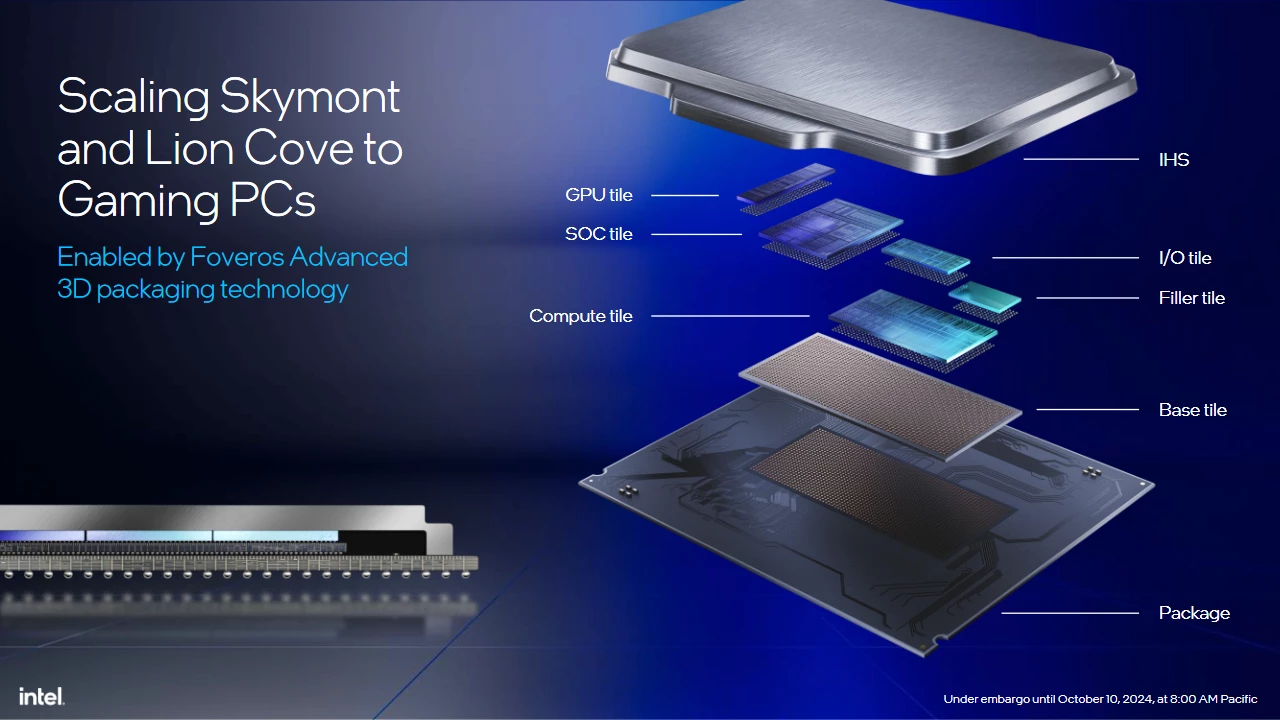
As mentioned previously, Intel Core Ultra 200 Arrow Lake series of CPUs will be the first ever CPU series by Intel with tile based architecture for desktop.
They will have the main compute tile, SoC tile, GPU tile and an IO tile and a dummy filler tile. All put together on a base tile on Intel’s Foveros Advanced 3D packaging technology.
For the first time on desktop, all the tiles are made not by Intel but by TSMC. The compute tile will be made on TSMC’s N3B process node, the GPU tile on N5P node, whereas the SoC and I/O tiles use TSMC’s N6 process node.
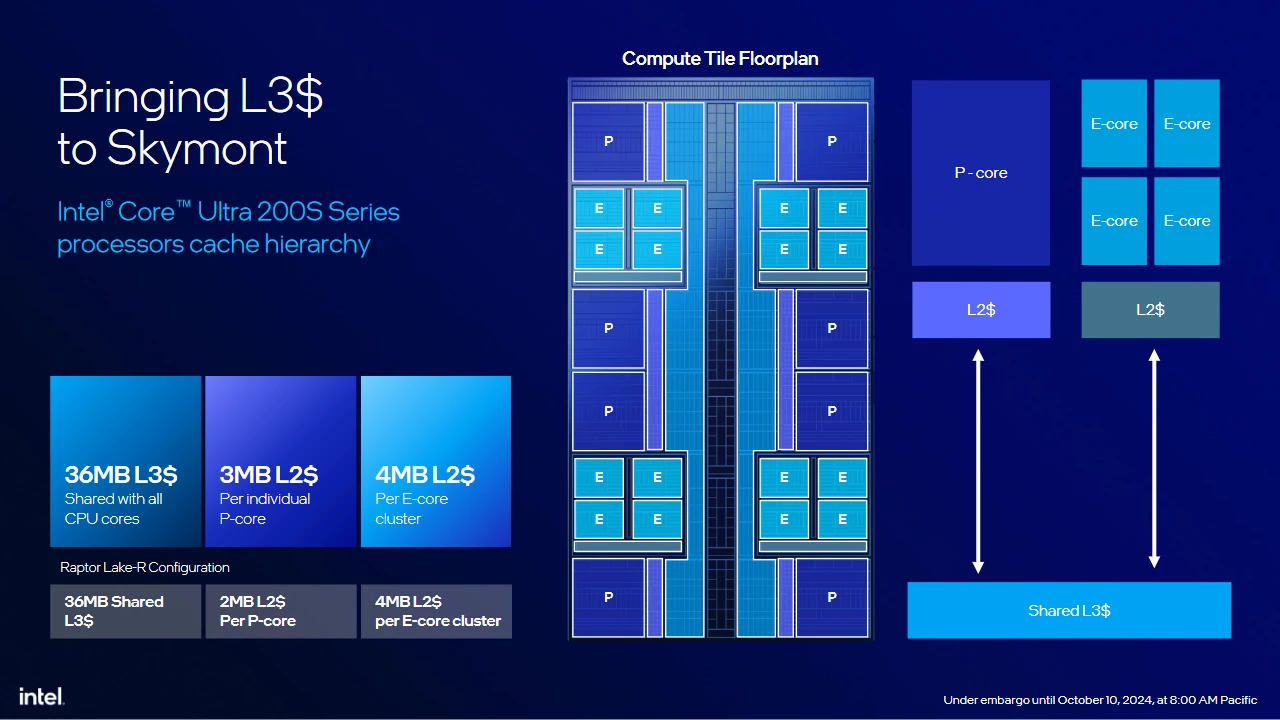
The compute tile too sees changes. The E-cores have been moved to quad clusters spread among P-Cores. Intel claims this allows them to reduce hotspots and share the total L3 cache between P-Cores and E-Cores.
Poor Gaming Performance
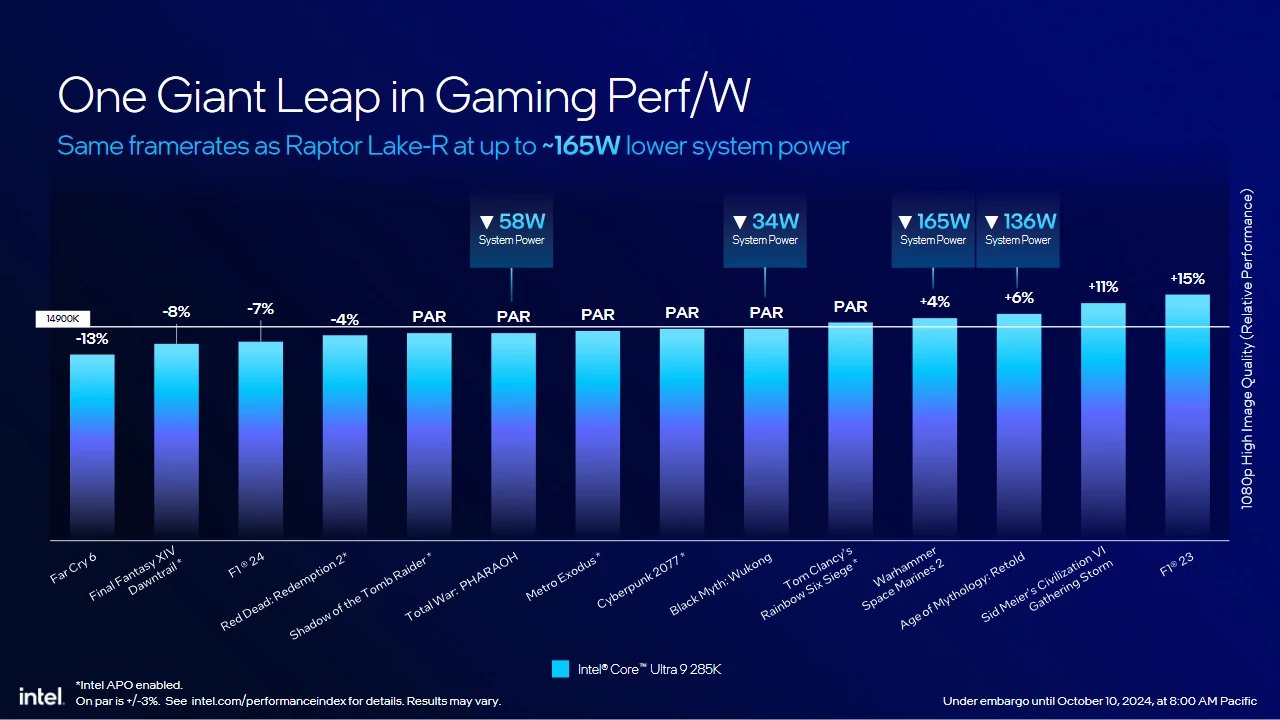
While Intel claims 9% uplift in P-Core performance, the gaming performance claims are going to raise eyebrows.
Intel claims that the gaming performance of Intel Core Ultra 9 285K is on par with Intel Core i9-14900K. Which is a massive disappointment. As we expect at least 10% increase in gaming performance in CPUs over previous-generations.
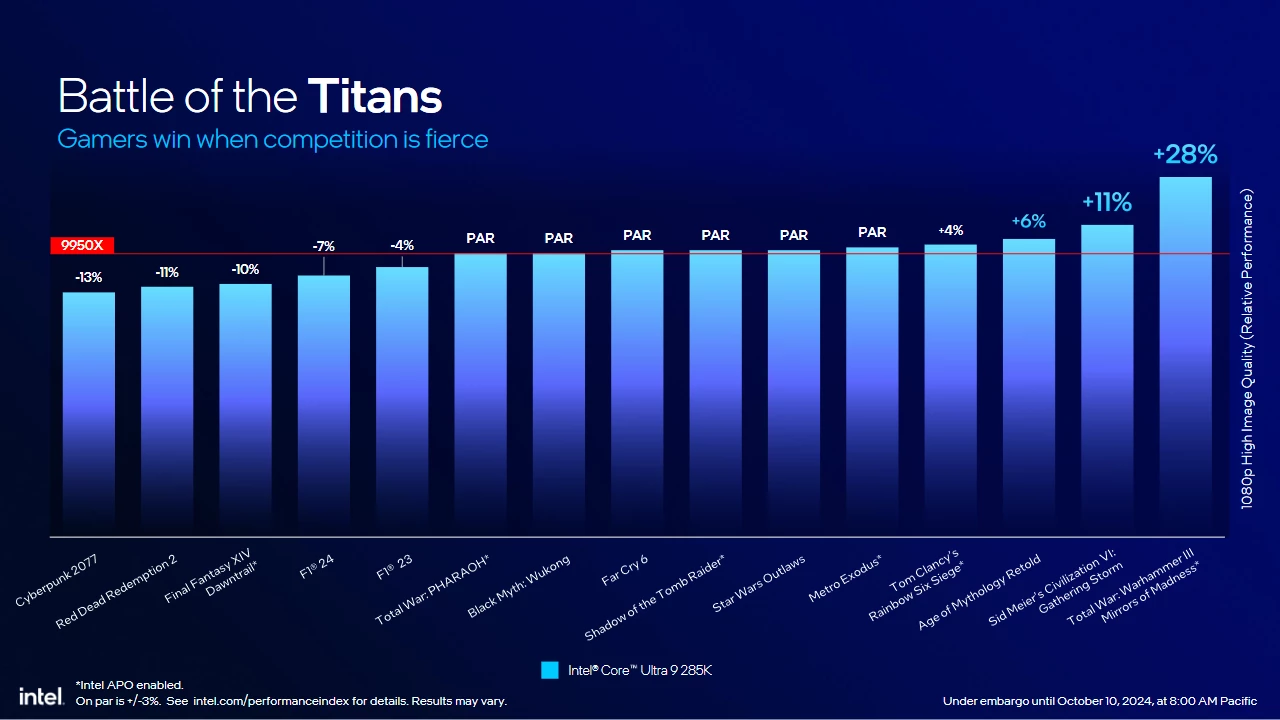

That’s not it. Based on the above Intel claims, Intel Core Ultra 9 285K is going to be on par of AMD Ryzen 9 9950X CPU and might be, in fact, slower than AMD Ryzen 7 7800X3D CPU in most of the games. This too is going to be a massive disappointment.
So bad is the gaming performance that the well known leaker kopite7kimi speculates that the Intel Core Ultra 9 285K can be slower than Intel Core i9-12900K CPU in gaming. If true, this can be a massive downgrade.
This can be attributed to the new tile based architecture and added latency caused due to the interconnect between tiles.
Power Usage Improvements
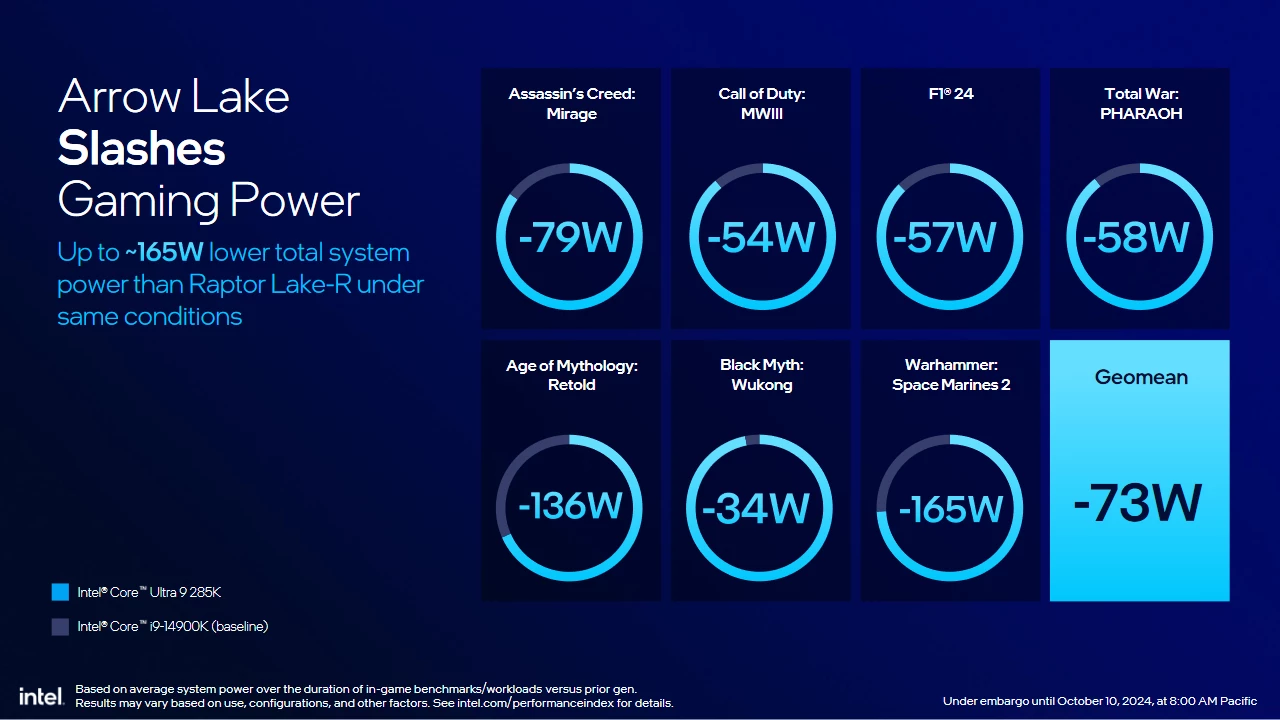
Despite disappointing gaming performance, Intel claims massive power efficiency improvements in the Intel Core Ultra 200 Arrow Lake CPUs.
When compared to Intel Core i9-14900K, Intel Core Ultra 9 285K on average uses almost 75W less power. With up to 165W lesser in one game. This is a massive improvement.
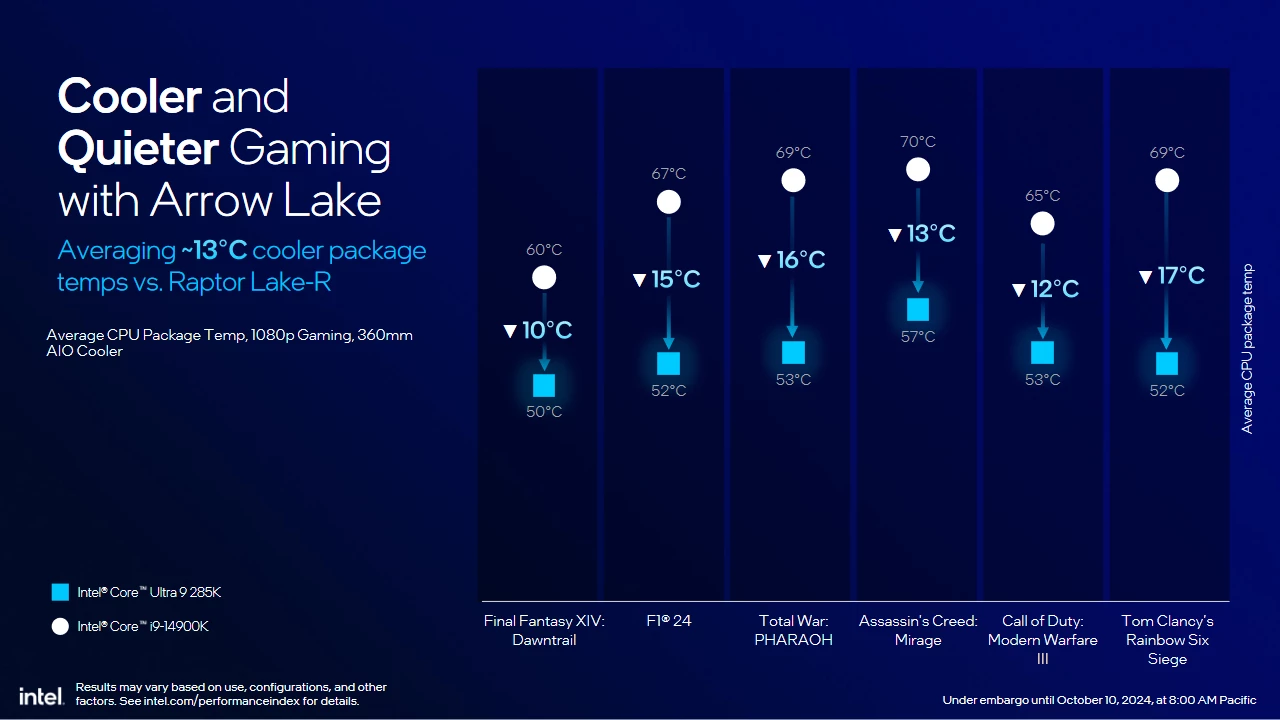
This has allowed Intel to reduce the temps anywhere from 10°C to a massive 17°C depending on the games.
By doing this, Intel has shown that it’s not AMD alone that can reduce the power usage of its CPUs.
Features & Release Date
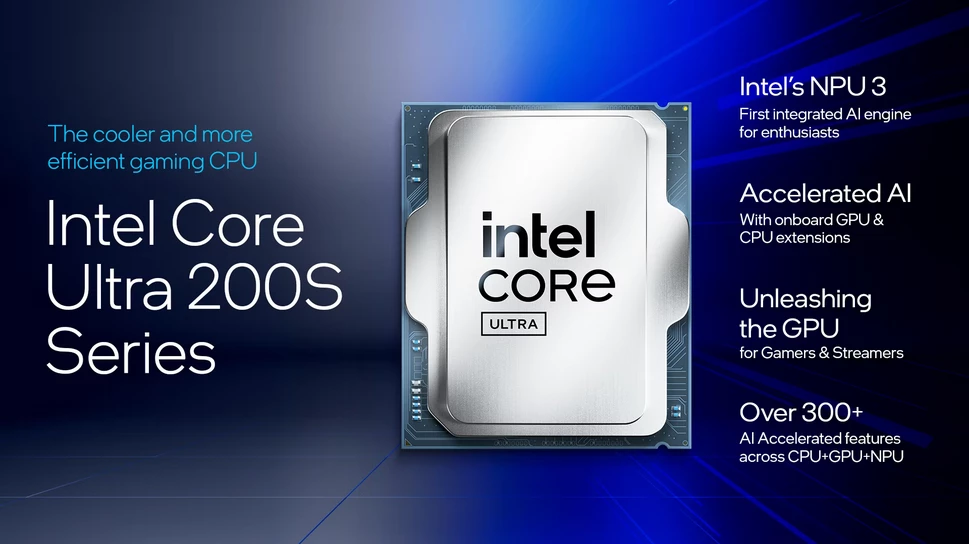
The Complete Enthusiast Solution: Intel Core Ultra 200S series processors offer excellent performance in AI and content creation, and power an immersive gaming experience, with up to 28% gaming performance uplift compared to competing flagship processors.
New Intel® 800 Series Chipset: Intel Core Ultra 200S series processors’ new Intel 800 Series chipset extends platform compatibility with up to 24 PCIe 4.0 lanes, up to 8 SATA 3.0 ports, and up to 10 USB 3.2 ports, empowering enthusiasts to take advantage of the latest connectivity, storage, and other technologies.
Overclocking Overhauled: Intel Core Ultra 200S series processors bring new overclocking functionality with fine-grain controls, with top turbo frequency in 16.6 MHz steps for P-cores and E-cores. A new memory controller supports fast, new XMP and CUDIMM DDR5 memory up to 48GB per DIMM for up to 192GB in total, and the Intel Extreme Tuning Utility now includes one-click overclocking enhancements.
Leading Connectivity: Intel Core Ultra 200S processors come equipped with 20 CPU PCIe 5.0 lanes, 4 CPU PCIe 4.0 lanes, support for 2 integrated Thunderbolt™ 4 ports, Wi-Fi 6E and Bluetooth 5.3. Intel® Killer™ Wi-Fi delivers supercharged wireless performance and enables seamless, immersive online gameplay through application priority auto-detection, bandwidth analysis and management, and smart AP selection and switching.
Multi-Engine Security: Intel® Silicon Security Engine helps preserve data confidentiality and code integrity while maintaining high performance for demanding AI workloads.
Intel Core Ultra 200 Arrow Lake CPUs will officially release and become available starting Oct. 24, 2024.
Conclusion
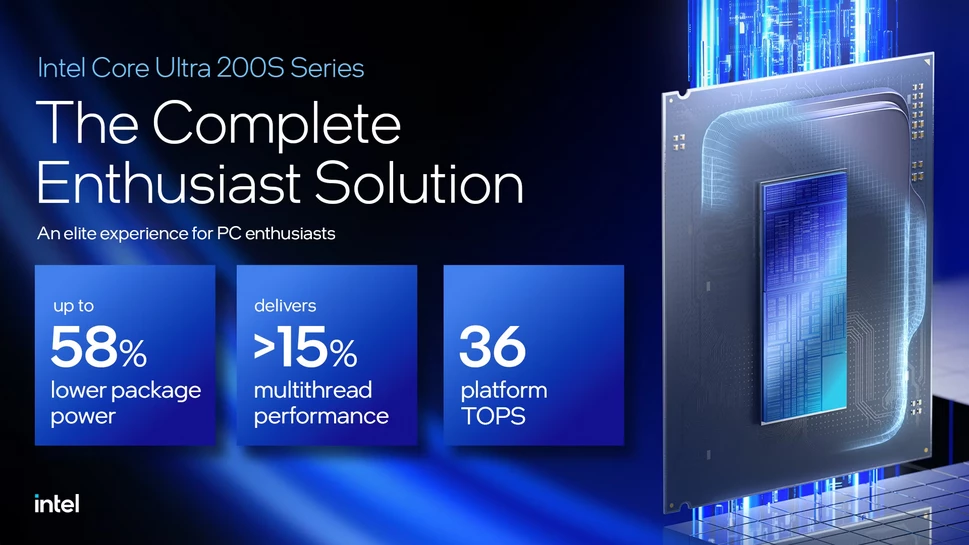
Intel is claiming good improvements in the performance of productivity software. But the gaming performance is expected to be the same or might even see reduction in performance. Possibly due to the new tile based architecture.
What’s impressive is the massive reduction in the power usage. 58% reduction in software and max 158W reduction in gaming.
It must be mentioned that these are Intel’s own claims, it means that when third party reviewers publish their reviews, which is likely around the release dates, that’s when we will actually see how true are Intel’s claims.
We feel that while power efficiency claims could be true, the gaming performance might see some further reduction. But we will come to know only when the public reviews are out everywhere.
RIP Matrix | Farewell my friend ![]()
Hope you enjoyed this news post.
Thank you for appreciating my time and effort posting news every day for many years.
2023: Over 5,800 news posts | 2024 (till end of September): 4,292 news posts



3175x175(CURRENT).thumb.jpg.b05acc060982b36f5891ba728e6d953c.jpg)
Recommended Comments
There are no comments to display.
Join the conversation
You can post now and register later. If you have an account, sign in now to post with your account.
Note: Your post will require moderator approval before it will be visible.